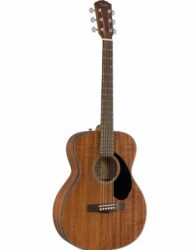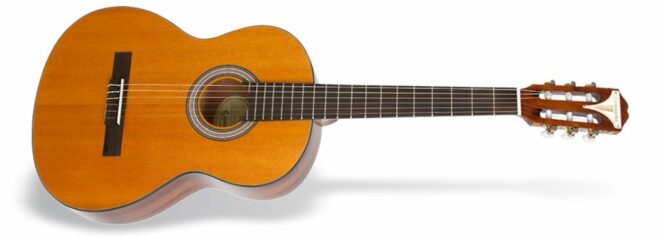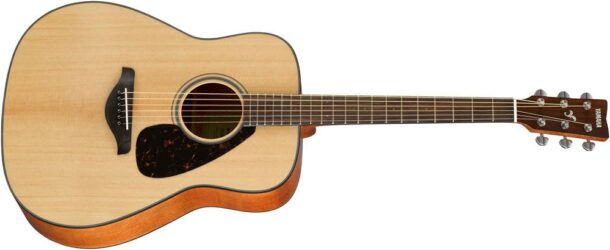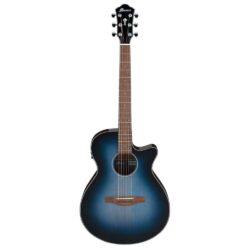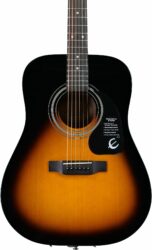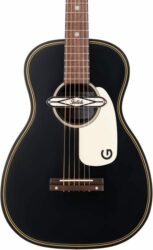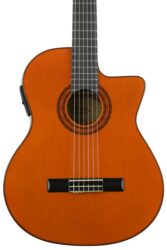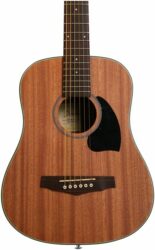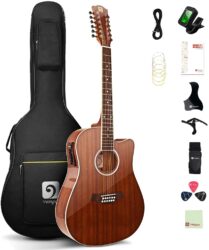Nothing has transcended genres and time like the acoustic guitar. Since the 1600s, people have been using them to woo partners, entertain campers, and add color to concert halls. Whether you love rock, flamenco, country, or just love vibing to video game music, chances are the humble acoustic guitar makes an appearance.
If you are looking to start your own musical journey with an acoustic guitar, then we have some great news. A lot has changed since the 1600s, and there has never been a better time to buy a beginner guitar.
In this guide, we’ll get you started fast. First, with a straightforward guide to choosing your first guitar, and then with a list of what we believe are the best beginner acoustic guitars on the market—with a sound sample for every instrument on our list.
Finally, at the bottom, we’ll include a much more in-depth look at guitar properties. That way, if you want, you can really fine-tune your selection.
- How to Choose Your First Guitar
- Top 10 Best Beginner Acoustic Guitars 2024
- 1. Best Overall Beginner Acoustic Guitar: Fender CC60S
- 2. Best Budget Beginner Acoustic Guitar: Epiphone Pro-1 Classic
- 3. Best Dreadnought-Style Beginner Acoustic Guitar: Yamaha FG800
- 4. Best-Looking Beginner Acoustic Guitar: Luna Henna Oasis
- 5. Best Premium Beginner Acoustic Guitar: Ibanez AEG50
- 6. Best Inexpensive Steel String Beginner Acoustic Guitar: Epiphone DR-100
- 7. Most Unique-Looking Beginner Acoustic Guitar: Gretsch G9520E Gin Rickey
- 8. Best Nylon Acoustic-Electric Beginner Acoustic Guitar: Washburn C5CE
- 9. Best Small Beginner Acoustic Guitar: Ibanez PF2MH ¾ Scale Guitar
- 10. Best Entry Level 12-String: Vangoa 12 String
- An In-Depth Guide to Beginner Acoustic Guitars
- Tune-Up and Have Fun
How to Choose Your First Guitar
The hardest part of playing the guitar is choosing one. It’s true; ask any professional, and you’ll find out how long they spend agonizing over minor details.
The good thing is that as a beginner, you’ll actually have a much easier time choosing a guitar because you don’t yet know what to agonize over. It’s something to look forward to.
There’s really only one thing you need to keep in mind, though. It’s the most important part of the equation, and it’s also the simplest.
Get the Guitar That Inspires You
Yes, the one that inspires you specifically. Not the one that critics say is best, or the one that costs the most. We’ll expand on it again in our detailed guide, but get the one that you look at and want to pick up and play.
This is true no matter what skill level you have or what instrument you are buying. It doesn’t matter if it’s Johnny Cash’s actual guitar; if it doesn’t speak to you, you won’t pick it up and play it. If you don’t pick it up and play it, you won’t get better.
What Makes a Good Beginner Acoustic Guitar?
There are hundreds of thousands of guitars on the market, so what makes one better for a beginner?
Sound Quality
First thing’s first, we have to dispel the worst myth associated with beginner guitars—that it’s impossible to achieve a great sound while playing them. An acoustic guitar’s sound quality has way more to do with how you play it than any other factor.
You don’t have to worry at all that you’ll never get an enjoyable sound until you move up to a more advanced instrument. If you would like some proof, here’s Black Label Society’s Zakk Wylde playing a cheap, child-sized Hello Kitty guitar and making it rock.
Price
Price is probably the thing that really makes a beginner guitar a beginner guitar. A high-end acoustic can easily surpass the price of a car. It’s impossible to justify paying that much if you are just starting out. We believe that the best introductory acoustics are between $100-300.
That’s an approachable price for most people. There are many options in that range, and it’s honestly hard to notice the benefits of a more expensive instrument unless you have a lot of experience.
Quality
There is, unfortunately, a lot of junk out there. Cheap import guitars that won’t stay in tune or have an action (action is how close the strings are to the neck) so high your fingers bleed every time you touch it will make you want to give up instantly. Refer to our most important point up above: if you don’t want to play it, you won’t.
Now we aren’t saying that all no-name, cheap guitars are bad. They are just bad for a beginner since they often require a lot of setting up or have, we’ll be polite, quirks that make them unfriendly. Sticking to established brands who have proven themselves over the years is usually the best way to make sure you get a decent instrument.
Types and Styles of Acoustic Guitars
The style and type of guitar is the biggest influence on how guitars sound and how you play them. We will get way more in-depth in the full guide below, but we’ll run through the basics here. These are the terms you’ll see used to describe guitars and what they mean.
Classical
Classical acoustic guitars use nylon strings and are usually easier to play than their steel counterparts. They are quieter, though.
Steel String
Steel string guitars use, you guessed it, steel strings. They are a little harder to play but much brighter in sound. This YouTube video does a great job contrasting them.
Dreadnought
Dreadnought is a size of guitar. It’s the most common size. They are bigger than a classical guitar and can generate a lot more volume. We’ll cover sizes in more detail here.
Cut-Away
A guitar with a cut-away has some of the body removed to make it easier to play more notes on the neck.
Acoustic-Electric
An acoustic guitar with an onboard electronic amplifier is known as an acoustic-electric, and it makes it easy to amplify.
That’s the basics. It’s easy to get buried under information and not know where to start. That’s why we’ll say again that the best advice is to get an instrument that you can see yourself playing. As you read through our reviews, picture yourself in your favorite place, and playing your favorite acoustic song with the guitar in question.
Top 10 Best Beginner Acoustic Guitars 2024
1. Best Overall Beginner Acoustic Guitar: Fender CC60S
Why we like it:
It says Fender on the headstock, it comes with a tuner, and it’s the perfect size for general playing. There’s just nothing to dislike.
Quick Specs:
- TypeSteel String
- SizeConcert
- Most Associated WithRock, Campfires, Playing Wonderwall at a Party
- Listen HereSound Sample
What Makes It a Good Beginner Acoustic Guitar?
The Fender CC60S just combines a lot of really good features that are all geared toward someone learning to play. It comes with a tuner, picks, and a (really mediocre) gig bag, so you don’t have to purchase them separately. Plus, it comes with lessons so you can get right into learning.
It’s not the easiest-to-play guitar on our list—one of the nylon guitars like the Epiphone here is more friendly for newbie hands—but it’s concert sized. It is the most universal in design, so you aren’t going to be running out of songs to play anytime soon.
Our Thoughts
It’s a Fender. Even if you’ve never seen a guitar in person, you probably know that Fender is one of the guitar world’s biggest brands. It’s also less than $200. It’s not the cheapest steel string on our list—that honor belongs to this Epiphone — but it’s still a really fantastic value.
The biggest flaws that the Fender CC60S has are flaws that any budget instrument will have: the tuners are not great, the finish won’t last a lifetime, and the frets aren’t as polished as they could be. You won’t notice any of that when you are starting out. If you like the look and just want an excellent general-purpose guitar, here’s your answer.
Pros
- Great quality for the price
- Comes with lots of beginner goodies
- Very versatile
Cons
- The included gig bag is not very good
- It’s not as easy to play as a nylon guitar
2. Best Budget Beginner Acoustic Guitar: Epiphone Pro-1 Classic
Why we like it:
Classic nylon guitars make perfect beginner guitars, and you can’t beat the price-to-quality ratio of this Epiphone.
Quick Specs:
- TypeNylon String
- SizeClassical
- Most Associated WithFlamenco, Classical, Django Reinhardt
- Listen HereSound Sample
What Makes It a Good Beginner Acoustic Guitar?
Nylon guitars just naturally make perfect beginner guitars. Nylon strings are easier on the fingers than steel strings, and classical guitars have wide, flat fretboards that are much more forgiving. Couple all that with the smaller size of the body, and you have a really great first instrument.
The Pro-1 Classic is very simple too, which is good for a focus on learning. Still, you may find yourself wanting a few more features to experiment with and help your style grow. In that case, check out the Washburn C5CE on our list. It costs a bit more, but the onboard electronics can help you break into the electric-acoustic world as well.
Our Thoughts
There really isn’t an easier guitar to play on our list. It’s got nothing complicated, and the style makes it very finger-friendly. It also sounds great; Epiphone is absolutely no slouch when it comes to quality. And just to top it all off, the antique finish looks excellent.
The only thing this guitar isn’t is versatile. It’s a small, nylon-stringed guitar with no electronics and no adjustability. Part of the fun of learning is experimenting, and the Pro-1 doesn’t give you much room to do that.
For the incredible price, though, if you are ok with settling for a beautiful sounding classical guitar, it’s a perfect learning tool.
Pros
- Finger-friendly, simple design
- Good looking
- High-quality
Cons
- Doesn’t lend itself well to experimentation
- You won’t get a lot of volume from it
3. Best Dreadnought-Style Beginner Acoustic Guitar: Yamaha FG800
Why we like it:
Full dreadnought sound. Beautiful Spruce and mahogany construction. Famous Yamaha build quality. Take your pick.
Quick Specs:
- TypeSteel String
- SizeDreadnought
- Most Associated WithFolk Music, Country, Busking on Street Corners
- Listen HereSound Sample
What Makes It a Good Beginner Acoustic Guitar?
A larger guitar like a dreadnought can be a little intimidating for a first-time player. The strings will be thicker and harder to press down, and if you have short arms, you might have a hard time working around the large body.
However, the volume and fullness of the tone will make up for those shortcomings. The best part about learning on the Yamaha FG is that it will grow with you. Ten years from now, when you are recording your second platinum album, you will still be able to grab the FG800 and record a track.
Our Thoughts
The FG800 is harder to play than a classical guitar like this Epiphone and a smaller steel-string like the Luna. Yamaha just knocks it out of the park with the build quality and tone, though.
First, that beautiful mahogany body is hiding neat construction techniques that give you the jumbo guitar volume. You can confidently set up without a mic and impress the entire bar.
Second, the neck on Yamaha’s FG series is the same fit and finish you’ll find on much, much more expensive guitars. That means when it’s time to move on from your first guitar, you won’t have to learn a totally new neck profile.
Pros
- Good volume and tone
- The neck is very nice
- It’ll survive years of abuse
Cons
- Thick, steel strings are hard on non-callused fingers
- The larger body can be uncomfortable, especially for smaller players
4. Best-Looking Beginner Acoustic Guitar: Luna Henna Oasis
Why we like it:
The only time the Luna Oasis looks better than it does hanging on your wall is when you bring it on stage.
Quick Specs:
- TypeSteel String Electric-Acoustic
- SizeConcert Single Cut-Away
- Most Associated With60s Music, Love Songs, Free Spirited Feel Good Music
- Listen HereSound Sample
What Makes It a Good Beginner Acoustic Guitar?
We dare you to walk by it and not want to pick it up and strum a few chords. That’s what makes it great; there’s no way you could have it sitting in your house and not want to practice and improve.
It’s also got a built-in tuner and an ok preamp. The preamp allows you to plug into an amp or directly into recording equipment. You aren’t going to get great electronics at beginner prices unless you pay more for the Ibanez on our list. Still, you will be able to learn how to use and best utilize an onboard preamp.
Our Thoughts
Luna makes stunning guitars, from their entry-level Henna line to the absolutely gorgeous Vista line. We have no shame in admitting that a big reason we love this guitar, especially for a beginner, is because of how good it looks for an entry-level instrument.
They are also very playable guitars. The single cut-away design gives you full access to their iconic fretboard featuring moons instead of dots, and the c-shaped neck is a lot more comfortable for smaller hands than the thicker necks than most acoustics have.
We do wish they had some designs that were less flower power and more punk. The Henna is beautiful but might feel out of place doing a Cash cover in a seedy bar. Then again, that juxtaposition can also be a lot of fun.
Pros
- Really good-looking
- Has an onboard tuner and preamp
- Very playable neck
Cons
- Electronics could be better
- Henna design isn’t for everyone
Why we like it:
The AEG50 will easily grow with you as you learn and sound great the entire time.
Quick Specs:
- TypeSteel String Acoustic-Electric
- SizeConcert
- Most Associated WithBlues, Rock, Being a Guitar God
- Listen HereSound Sample
What Makes It a Good Beginner Acoustic Guitar?
The Ibanez AEG50 is on the line between being a beginner guitar and being an intermediate guitar. That’s partially due to the price, but it’s also because it’s not doing anything to help you as a new player. The onboard electronics are of higher quality than the Luna guitar’s electronics, but they require a bit more finesse. The body is a very comfortable single cut-away design, but it’s a bit unforgiving. The shallow design doesn’t have the volume or bass to cover up mistakes.
Those same properties that make it a bit harder on beginners also make it great to grow with. You’ll really love those electronics when you’re on stage or in a recording booth and are dialing in the sound with an amp. You’ll welcome the harder to press strings and responsive body because they allow you to do things like perform huge bends and long legato runs. Right about the time you’d be thinking of upgrading from something like this Epiphone guitar on our list, the Ibanez will be hitting its stride.
Our Thoughts
Ibanez is probably most well known for being the brand of choice for the virtuoso. Steve Vai, Joe Satriani, and Paul Gilbert all use Ibanez electric and acoustic guitars and are some of the most innovative guitarists to take the stage. That mentality shows through with this AEG.
It’s got a blue burst pattern that bucks the traditional natural finishes of most acoustics, and the onboard electronics feature a shape knob instead of an equalizer. It’s begging you to practice hammer-ons and alternate picking instead of the same five chords every day.
You just need to be prepared to take the extra step and experiment with what a shape knob does.
Pros
- Has good electronics for the price
- Encourages you to experiment
- Ibanez is well known for its craftsmanship
Cons
- It’s a bit expensive for an entry level-guitar
- The electronics are not very intuitive
6. Best Inexpensive Steel String Beginner Acoustic Guitar: Epiphone DR-100
Why we like it:
This is the least expensive steel guitar on our list. It’s a full-sized dreadnought made by Epiphone, and it punches way above what the price suggests.
Quick Specs:
- TypeSteel String
- SizeDreadnought
- Most Associated WithCountry, Bluegrass, Being the One Acoustic Guitar the Person With 30 Electric Guitars Has
- Listen HereSound Sample
What Makes It a Good Beginner Acoustic Guitar?
It’s very inexpensive, but it doesn’t enter the realm of the cheap junk guitar. The price alone is one of the best reasons it’s a good beginner instrument; there’s no risk. You won’t be out a lot of money if you buy it and then decide you don’t like playing.
The steel strings do make it a bit harder on new players until the calluses grow in. It’s also bigger than classical guitars, so smaller players may find themselves fighting with the size.
Our Thoughts
Just like the other Epiphone on our list, the DR-100 is a simple, no-nonsense guitar that sounds fine and is built to a high standard of quality. It’s just a steel-string instead of a nylon string. That lets it transcend its entry-level status.
Out in the wild, you’re most likely to see the DR-100 mixed into a collection of electric guitars. Long time electric players who already have baked in brand affiliations and who want to give acoustics a try will own one. They will see the Epiphone logo, notice the price, and buy it guilt-free. Then they’ll keep playing it because it’s an excellent guitar for the price. If you are a beginner, you’ll just be taking advantage of all the knowledge those people already bring to the table.
If you are trying to choose between the two, they are both great choices, so you can’t go wrong. Basically, if you plan to play at home and learn solo guitar music, get the Classic. If you plan on playing around a campfire, at a local bar, or want to back up a singer, get this DR-100.
Pros
- Inexpensive
- High-quality
- Good sounding for the price
Cons
- Steel strings can be hard on new students
- The larger size makes it difficult to play if you are on the small side
7. Most Unique-Looking Beginner Acoustic Guitar: Gretsch G9520E Gin Rickey
Why we like it:
It looks unusual, has a really unique sound, and is small and easy to play.
Quick Specs:
- TypeSteel String Acoustic-Electric
- SizeVintage Parlor (Which in this context means small)
- Most Associated WithBlues, Surf Rock, Accompanying a Banjo
- Listen HereSound Sample
What Makes It a Good Beginner Acoustic Guitar?
Not everyone wants to learn on a guitar that is just like every other guitar. Enter in the Gretsch Gin Rickey. We guarantee you’ll be the only one in your beginning guitar class with one like it.
Is that good? Yes, if you refer to rule number one: buy a guitar you want to play. It sounds great. It has a tiny body that makes it really comfortable for children or people with smaller frames, and it looks totally unique.
The small size might leave some people wanting in the tone and volume department. It’s quieter and thinner sounding than the other small guitar on our list, the Ibanez PF2MH. That’s because of the big electric pickup in the middle of the soundhole. But the pickup is absolutely awesome if you want to plug it in and get into Louisiana Blues. It is a little inconvenient if you just want to practice some acoustic melodies.
Our Thoughts
The Gin Rickey is likely the most polarizing entry on our list. It’s named after a cocktail, made by a company that’s synonymous with the American South, and it looks like something from a steampunk novel.
If that sounds awesome to you, then you’ll love it. We just have to suggest getting an amp to go with it, and a slide. We also suggest a healthy dose of inspiration from one of the absolute kings of slide guitar, Justin Johnson.
Pros
- Has a totally unique look
- Small size is great for beginners
- Sounds absolutely wonderful plugged in
Cons
- You should really get an amp to go with it
- The unique look isn’t for everyone
8. Best Nylon Acoustic-Electric Beginner Acoustic Guitar: Washburn C5CE
Why we like it:
Sometimes, you want the whole pub to hear your classical guitar, not just the front row.
Quick Specs:
- TypeNylon String Acoustic-Electric
- SizeClassical
- Most Associated WithSpanish Music, Video Game Music
- Listen HereSound Sample
What Makes It a Good Beginner Acoustic Guitar?
We said it before when discussing the Epiphone classical guitar, but nylon string guitars are easier to play for beginners. The strings have more space between them to isolate individual notes better. The strings are easier on your fingers and take less effort to fret correctly.
Unlike the Epiphone, this Washburn features a single cut-away, making it easier to access the higher frets. That’s probably not a big deal for you if you are just starting out, but down the road, when you want to crank out some solos, it will come in handy. It’s also got electronics, including a built-in tuner. That makes it plugin ready, which is somewhat rare with a classical guitar.
Our Thoughts
Having a nylon that can plug into an amp without needing extra mics can be super handy for overcoming the biggest shortfall of a classical guitar. If you have an amp, you won’t have to worry about being drowned out by traffic going by outside your window.
The electronics are a little cheap. They definitely aren’t as nice as the Ibanez AEG, but they will get you tuned and amped. The overall quality isn’t as good as some of the bigger brands on our list either. It’s not bad by any means, but you’ll want to adjust it a bit from the factory to get the most out of your experience. A simple fret filing, new strings, a neck adjustment, and you’ll be good.
Pros
- Easy to play
- Has good access to the fretboard, especially for a nylon string
- Includes an onboard tuner and preamp
Cons
- The quality of the electronics could be better
- Will need some setup from the factory
9. Best Small Beginner Acoustic Guitar: Ibanez PF2MH ¾ Scale Guitar
Why we like it:
Whether you have a tiny frame or just want a guitar that’s really easy to travel with, the Ibanez 3/4 is perfect.
Quick Specs:
- TypeSteel String
- Size¾
- Most Associated WithChild Guitar Prodigies, Street Fairs, People Who Don’t Travel Without a Guitar
- Listen HereSound Sample
What Makes It a Good Beginner Acoustic Guitar?
The PF2MH is a ¾ guitar. That means that it’s ¾ the size of a traditional dreadnought. The neck is shorter, the body is smaller, and the frets are closer together. If you have small hands or short arms, that makes it a really great entry-level guitar. It’s also great for travel. The small size is easy to throw in the trunk of your car and haul to lessons.
The small size, unfortunately, hurts the tone and volume. That’s always the tradeoff with acoustic instruments—the smaller the instrument, the less bass response, and the less volume. Don’t worry about what bass response means right now. Just know that part of what makes a big guitar sound full and vibrant is lost when you shrink it down.
Our Thoughts
Travel and small-bodied guitars have gotten so good over the last decade that it’s hard not to want one no matter what your skill level is. It used to be that you would lose all semblance of quality tone from the small body. Nowadays, you can pick up a very inexpensive travel guitar like this Ibanez and jam without sacrificing too much.
That makes it perfect not just for travelers and children, but anyone learning guitar who’s on a budget or lives in a dorm and just doesn’t have the space for a massive acoustic guitar.
There is one reason you should look away, and it has to do with the size of your hands. Allow us to get technical for a moment; the scale is the distance between the nut and the bridge. The shorter scale means you have a lot less room to move around on the fretboard, and if you have big hands, it can be downright uncomfortable. The Gretsch is a small-bodied guitar with a longer scale, so you still have options if you are space limited.
Pros
- Great for smaller players and children
- Great for travel too
- Inexpensive
Cons
- The tone isn’t as good as a full size-guitar
- Short scale can be uncomfortable
10. Best Entry Level 12-String: Vangoa 12 String
Why we like it:
If you have a powerful need to play Led Zeppelin or Bon Jovi tunes and are willing to put in the extra work that a 12-string demands, the Vangoa is an incredible value.
Quick Specs:
- TypeSteel String Acoustic-Electric 12-String
- SizeSingle Cut-Away Dreadnought
- Most Associated WithJimmy Page, Pink Floyd, Bon Jovi, Any Hard Rock Song With an Acoustic Intro
- Listen HereSound Sample
What Makes It a Good Beginner Acoustic Guitar?
We are going to be honest: it’s not. It’s not a good beginner guitar, and we would never suggest someone learn guitar on a 12-string. They are hard to play, they are hard to tune, and they are nearly impossible to adjust correctly.
That being said, there isn’t any substitute. If you really want to play guitar, and the reason you want to play guitar is because of that amazing resonance only a 12-string produces, you need one to practice on. The Vangoa 12 String is inexpensive enough to buy it as a beginner, and you won’t have to worry too much about harming it as you learn. It also includes many beginner goodies, like a tuner, strap, and extra strings, which is nice.
Our Thoughts
If you are not familiar with the difference in sound between a standard 6 string and a 12 string, give this video a watch. The player does a good job contrasting songs side by side with both styles of guitar. That haunting, droning sound is unique to 12-string guitars, and once you can identify it, you’ll be able to pick it out on a lot of your favorite songs. Led Zeppelin uses 12-strings a lot, although technically Page’s stage guitar is both a 6 and a 12. It’s an SG with two necks; it’s wild.
Unfortunately, the only way to practice playing on a 12-string is to own a 12-string. They feel different, are harder to play, and require different tuning techniques than a standard guitar. That’s where this Vangoa really comes in. It looks terrific, and it costs very little for a 12-string. It’s the perfect thing to pick up and learn on.
Our suggestion is that if you really want to learn on a 12-string, pick up something like the Epiphone classical too. That way, you can still practice making chord shapes and strumming after the 12-string destroys your fingertips.
Pros
- Looks great
- Very inexpensive for a 12-string
- Includes a lot of beginner goodies
Cons
- 12-strings are hard to play
- Vangoa is a newer brand that doesn’t have much clout
An In-Depth Guide to Beginner Acoustic Guitars
With those reviews over, hopefully you are feeling inspired to grab a guitar and start learning. If you still need some more information, though, then we want to give it to you in this section. Let’s start by reiterating that getting a guitar that inspires you is more important than knowing the specs.
There’s No Right Reason to Be Inspired
We can’t tell you why a particular guitar can make you feel good. Maybe it’s similar to the guitar that the guy on the street corner played when you had your first kiss. Perhaps it just looks really damn cool, or maybe you just always dreamed of owning a Fender Guitar. It doesn’t matter what your reason is.
When you look through our recommendations, as disgustingly cliche as it sounds, let your heart guide you. You’ll have more fun owning an instrument you like, even if it sucks, than an instrument that just sits and collects dust in a case. As you play your first guitar, your tastes and wants will evolve, and you’ll join us in the never-ending cycle of buying, playing, and refining.
The Different Types of Acoustic Guitars
We hit on the basics up above, but the basics rarely tell the whole story. Guitars come in a lot of shapes and sizes and a few different configurations. Rather than explain each label, the best way to understand the different guitars out there is to look at their broader categories. There are two main ways to categorize a guitar, and there’s a lot of crossover between types.
By the Number and Material of the Strings
The first way to define a guitar is by the type of strings, either nylon or steel, and the number of strings. A classical guitar, like the Epiphone Pro-1, uses 6 nylon strings. That’s simple enough. A steel-string like the Fender CC60S uses steel strings, and a 12-string like the Vangoa 12 String has, you guessed it, 12-strings. Easy, right?
Nylon strings are quieter and more comfortable to play. It takes less effort to press them down, and the physical properties of nylon strings make them easier on your fingers.
Steel strings are harder to play, but you get a much brighter, louder sound out of them. They are also much more common because they are louder and because they are the only strings you can use on a traditional electric guitar.
By the Size of the Acoustic Guitar
The next category for defining a guitar is the size. It’s a little more complicated than the strings because sometimes manufacturers will use different words to describe the same thing. There are two main measurements for size: the volume or amount of space the guitar takes up, and the scale, which is the length of the neck. It’s a little more complicated than that, but that’s a good enough definition for now.
Those measurements are easy to understand. The more space a guitar takes up, the more volume you’ll get, and the deeper the tones will be. The longer the scale, the further apart the frets will be, and the longer you have to reach to play different notes.
Defining the size is where things get tricky. The scale is just a number. It represents the length from nut to bridge in inches and is usually 24.75 or 25.5. That’s Gibson standard and Fender standard respectively, in case you wanted to know why those two numbers are so common. The volume and shape are where manufacturers like to take liberties. For the sake of simplicity this is the standard breakdown of shapes from largest to smallest:
- Jumbo. Their large size makes them difficult for beginners to play, so we left them off this list.
- Dreadnaught, like the Yamaha FG.
- Concert, like the Luna Henna.
- Classical, like the Epiphone Pro-1.
- Parlor, like the Gretsch Gin Rickey.
- Small Scale (¾, ½, Child Size, Travel), like the Ibanez ¾.

Must-Have Accessories for New Acoustic Guitarists
Some guitars will include some of these accessories. The Fender we recommend, for instance, comes with a tuner, picks, a strap, and a case. You’re good to go right out of the box. These things can be upgraded, so while the Fender does come with a strap, you might want a more comfortable one for your situation.
Picks
When you are just starting out, get a variety of picks to experiment with. There’s no right one. Dunlop is one of the most well-known pick brands, and they sell a great variety pack here. They are cheap, which is good because you will lose them. And then find them in your wallet somehow four years from now; picks are mysterious like that.
A Good Strap
Cheap straps are fine for about 15 minutes worth of playing, and then they start cutting off the circulation to your arm. The good news is that a good strap, like this one, still doesn’t cost very much and makes a huge difference.
A Tuner
Tuners are absolutely essential for playing guitar. You know when someone sings a song, and it’s really bad and off-key? That’s how you will sound all the time if you don’t have a tuner.
There are many styles, but a simple clip-on like this one is one of the most universal. You can also just use your smartphone. Guitar Tuna is a really great tuning app, and it’s free, so there’s no excuse.
A Bag or Case
These aren’t fully necessary unless you want to carry your guitar around or protect it from the elements. Storage options range from simple nylon bags to padded soft cases, to hard-shell airline proof safes.
Which one is best for you will come down to your budget and the size of your guitar. Some guitar sizes don’t have many options, so it’s important to double-check that before buying.
A Stand
There are hundreds of styles of guitar stands. There are two we recommend for starting out, but chances are as you grow your collection, you’ll refine your taste. The first is a floor stand with a neck lock. The neck lock will prevent you from just knocking the guitar over accidentally; a head breaking off the neck is the number one way to break a guitar.
The second is a wall hanger. Wall hangers are nice because they are still convenient, but the guitar can’t be knocked over by a careless pet. They also don’t take up floor space.
An Amp
You don’t really need an amp. Even the acoustic-electrics that are more electric, like the Gretsch on our list, will play just fine without an amp. However, if you have an acoustic-electric, having an amp opens up a world of options for you to experiment with.
We recommend the Roland Micro Cube. It’s portable, can be made to sound like a lot of different amplifier styles, has onboard effects, and doesn’t cost very much. Don’t forget the cable.
Setting Up Your New Acoustic Guitar
If you can, have your guitar professionally set up. A bad guitar set up well is a better instrument than an amazing guitar adjusted poorly. Guitar Center will adjust and set up a guitar for $50, and your local music store might do it for free if you buy something from them or bring them donuts.
It can be hard to justify spending so much on a budget, especially when the setup would cost more than half the guitar’s entire cost. What we suggest is to have the guitar adjusted when you need your first set of new strings. That way you’ll have put some good time into playing and know if you want to continue, and you’ll be able to really take advantage of the better setup.
Tune out Other’s Subjective Guitar Preferences
As a beginner, your number one focus should be on learning to play. Still, as you immerse yourself in the guitar world, you will come across a lot of arguments. Many will center around the materials the guitar is made from. You’ll notice we didn’t put much emphasis on the materials in our reviews, and that’s because it’s highly subjective.
As a beginner, you probably don’t know what sound you want and how the wood or setup can affect that sound. That rings true when you move onto other subjective topics, like the shape, looks, neck style, tuners, bridges, whatever.
Don’t fall for the myth that there is a “best.” Guitar playing is a personal journey, and you will discover all these things for yourself. How you play, and what you want, is way more important than what some critic thinks is a good guitar.
Tune-Up and Have Fun
Playing guitar is rewarding. It will help you appreciate music better and give you a perfect party trick for any social situation. It’s a hobby that continually challenges you and allows you to express your own life through sound.
Pick up a guitar and give it a try. Grab the one that speaks to you so you can start your own journey and enjoy the learning process.

